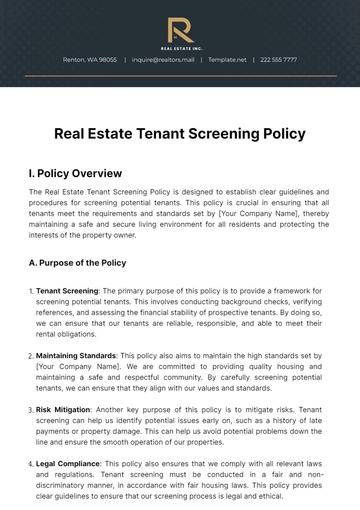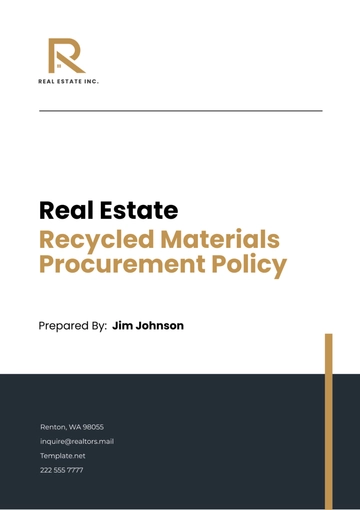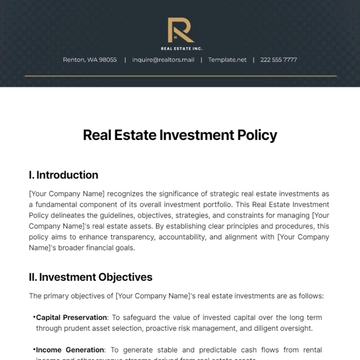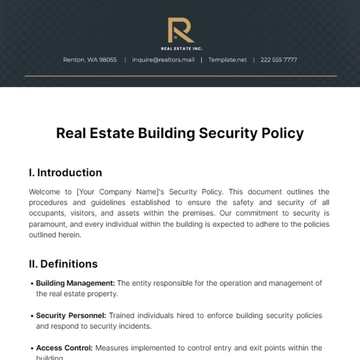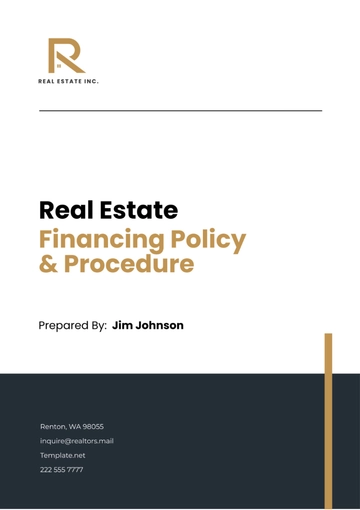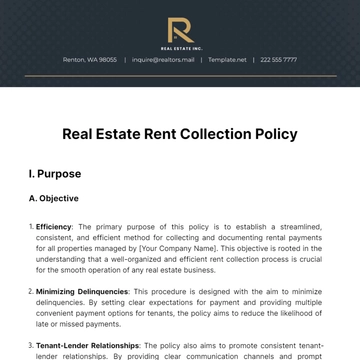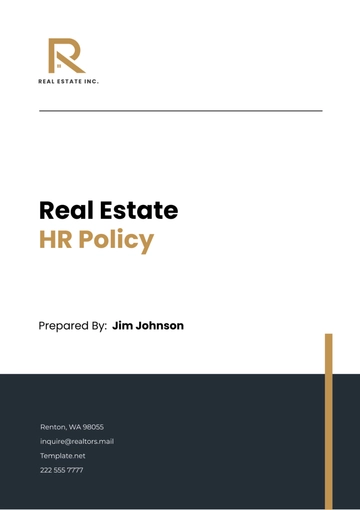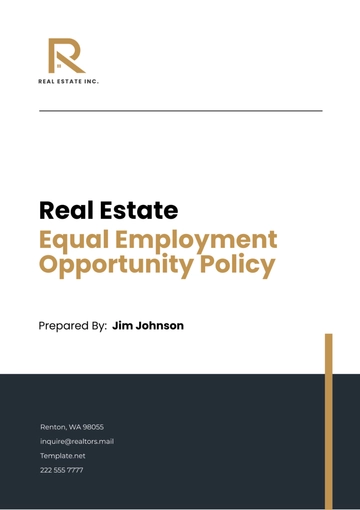Free Real Estate Equal Employment Opportunity Policy
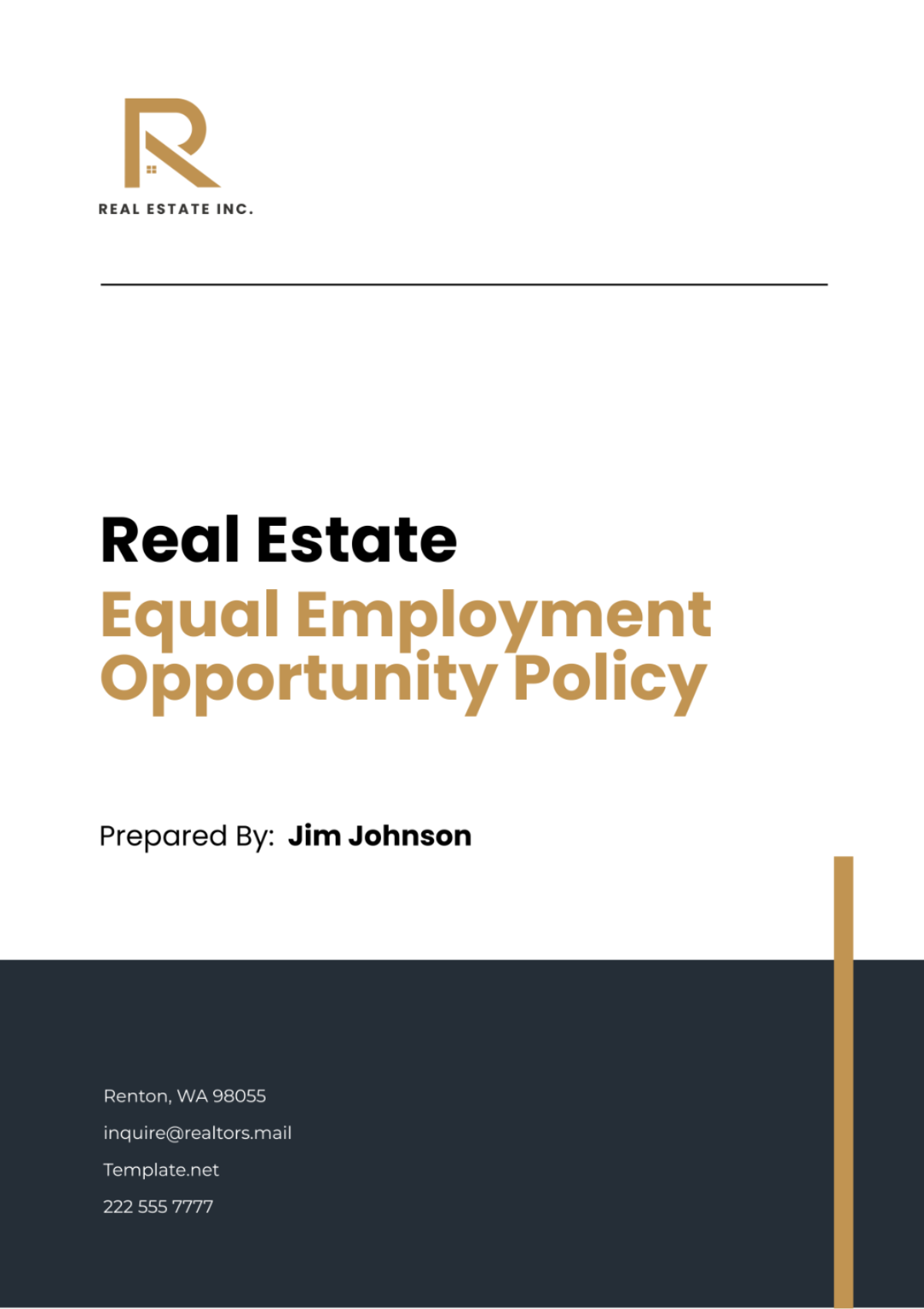
I. Introduction
At [Your Company Name], we prioritize creating an environment where every individual feels valued, respected, and empowered to contribute their unique talents. Our commitment to equal employment opportunity (EEO) stems from the belief that diversity enriches our workplace and fosters innovation and growth. Through this policy, we reaffirm our dedication to maintaining a fair and inclusive workplace culture that promotes fairness, equality, and respect for all employees and applicants.
II. Non-Discrimination
[Your Company Name] is firmly committed to providing equal employment opportunities to all individuals without regard to:
Race
Color
Religion
Sex
Sexual orientation
Gender identity or expression
National origin
Age
Disability
Genetic information
Marital status
Citizenship status
Veteran status
We prohibit discrimination in all aspects of employment, including but not limited to recruitment, hiring, training, promotion, compensation, benefits, and termination. Any form of discrimination is inconsistent with our values and will not be tolerated.
III. Equal Opportunity
We believe in providing equal opportunities for all employees and applicants based on their qualifications, skills, and abilities. Decisions related to employment, including recruitment, hiring, promotion, and assignment of duties, will be made solely on the basis of merit, without regard to any protected characteristic. We are committed to creating a level playing field where every individual has the chance to succeed and thrive in their careers.
Through our commitment to equal opportunity, we aim to build a workforce that reflects the rich diversity of the communities we serve and that empowers every individual to reach their full potential. We understand that promoting equality and fairness is not only the right thing to do but also essential for our continued success as an organization. As such, we are dedicated to upholding these principles in all aspects of our operations and fostering an environment where every employee feels valued, respected, and supported in their professional growth and development.
IV. Compliance with Laws
[Your Company Name] is committed to complying with all applicable federal, state, and local laws and regulations pertaining to equal employment opportunity and non-discrimination. We will also adhere to any relevant industry standards and best practices to ensure that our employment practices are fair, transparent, and in line with legal requirements. Compliance with these laws and regulations is fundamental to our commitment to creating a workplace that is free from discrimination and harassment. These laws include:
Title VII of the Civil Rights Act of 1964: Title VII prohibits employment discrimination based on race, color, religion, sex, or national origin. It applies to employers with 15 or more employees, including state and local governments.
Age Discrimination in Employment Act (ADEA): The ADEA protects individuals who are 40 years of age or older from employment discrimination based on age. It applies to employers with 20 or more employees, including state and local governments.
Americans with Disabilities Act (ADA): The ADA prohibits discrimination against individuals with disabilities in all aspects of employment, including hiring, promotion, and compensation. It also requires employers to provide reasonable accommodations to qualified individuals with disabilities. The ADA applies to employers with 15 or more employees.
Genetic Information Nondiscrimination Act (GINA): GINA prohibits employment discrimination based on genetic information and restricts employers from requesting, requiring, or purchasing genetic information about employees or applicants. It applies to employers with 15 or more employees, including state and local governments.
Title I of the Americans with Disabilities Act (ADA): Title I of the ADA prohibits discrimination against qualified individuals with disabilities in employment. It applies to private employers with 15 or more employees, state and local governments, employment agencies, labor unions, and joint labor-management committees.
Equal Pay Act of 1963: The Equal Pay Act prohibits wage discrimination based on sex by employers who engage in interstate commerce. It requires that men and women be given equal pay for equal work in the same establishment.
State and Local Anti-Discrimination Laws: In addition to federal laws, [Your Company Name] will also comply with relevant state and local anti-discrimination laws and regulations that may provide additional protections to employees based on characteristics such as sexual orientation, gender identity, and marital status.
V. Diversity and Inclusion
We recognize that diversity is not only a moral imperative but also a strategic advantage. [Your Company Name] is dedicated to fostering a diverse and inclusive workplace where individuals from all backgrounds feel welcome, respected, and valued. We believe that diversity sparks creativity, drives innovation, and leads to better decision-making. Through our commitment to diversity and inclusion, we aim to create a workplace culture where everyone can reach their full potential and contribute to our collective success.
VI. Harassment Prevention
Harassment in any form is unacceptable and will not be tolerated at [Your Company Name]. We are committed to maintaining a work environment that is free from harassment, intimidation, and hostility. This includes but is not limited to harassment based on race, color, religion, sex, sexual orientation, gender identity or expression, national origin, age, disability, or any other protected characteristic. [Your Company Name] implements various preventive measures to ensure a workplace free from harassment and discrimination. These preventive measures include:
Establishment of Clear Policies: [Your Company Name] maintains clear policies prohibiting harassment, discrimination, and retaliation in the workplace. These policies are communicated to all employees through employee handbooks, training sessions, and other appropriate channels.
Employee Training and Education: Regular training sessions are conducted for all employees to raise awareness about harassment, discrimination, and appropriate workplace behavior. Employees receive training on recognizing and reporting harassment, as well as understanding the consequences of engaging in harassing behavior.
Managerial Training: Managers and supervisors receive additional training on how to prevent and address harassment and discrimination in the workplace. They are trained to recognize signs of harassment, respond promptly to complaints, and take appropriate corrective action.
Promotion of Respectful Workplace Culture: [Your Company Name] fosters a workplace culture that values respect, diversity, and inclusion. This includes promoting open communication, teamwork, and mutual respect among employees at all levels of the organization.
Encouragement of Reporting: [Your Company Name] encourages employees to report any incidents of harassment, discrimination, or retaliation promptly. Employees are assured that all reports will be taken seriously and handled confidentially, without fear of retaliation.
Establishment of Reporting Procedures: Clear and accessible procedures are in place for employees to report incidents of harassment or discrimination. Employees are provided with multiple reporting options, including reporting to their supervisor, human resources department, or designated contact person.
Prompt and Thorough Investigations: [Your Company Name] is committed to conducting prompt and thorough investigations into all reports of harassment or discrimination. Investigations are conducted impartially and with sensitivity to the privacy and confidentiality of all parties involved.
Enforcement of Policies: [Your Company Name] enforces its harassment prevention policies consistently and fairly. Employees who engage in harassing behavior are subject to disciplinary action, up to and including termination of employment, in accordance with company policies and applicable laws.
Regular Review and Updates: [Your Company Name] regularly reviews and updates its harassment prevention policies and procedures to ensure they remain effective and compliant with evolving legal standards and best practices.
VII. Accommodation for Disabilities
[Your Company Name] is committed to providing reasonable accommodations to qualified employees with disabilities to ensure they can perform their job duties effectively. These accommodations made by the company are as follows:
Modification of Workstations: Adjustments to workstations, such as ergonomic furniture or specialized equipment, to accommodate employees with mobility impairments or other physical disabilities.
Flexible Work Arrangements: Offering flexible work schedules or telecommuting options to accommodate employees with disabilities who may require additional rest periods or have transportation challenges.
Assistive Technology: Providing assistive technology devices or software, such as screen readers or voice recognition software, to employees with visual impairments or other disabilities that affect computer use.
Job Restructuring: Modifying job duties or responsibilities to better match the abilities and limitations of employees with disabilities, while still meeting the essential functions of the job.
Accessible Facilities: Ensuring that workplace facilities, including restrooms, break rooms, and meeting rooms, are accessible to employees with disabilities, such as by installing ramps, handrails, or accessible parking spaces.
Support Services: Providing support services, such as sign language interpreters or personal care attendants, to assist employees with disabilities in performing their job duties effectively.
Training and Education: Offering training and education programs to supervisors and coworkers to increase awareness and understanding of disabilities and how to interact and communicate effectively with employees who have disabilities.
Temporary Assignments: Offering temporary assignments or alternative duties to employees recovering from injuries or medical conditions that temporarily limit their ability to perform their regular job duties.
Accessible Communication: Providing information and communication in accessible formats, such as large print, braille, or electronic formats, to employees with disabilities who may have difficulty accessing standard written materials.
Interactive Process: Engaging in an interactive process with employees to identify their specific accommodation needs and determine appropriate accommodations on an individualized basis.
VIII. Accountability
At [Your Company Name], we take violations of our Equal Employment Opportunity (EEO) Policy, including acts of discrimination, harassment, or retaliation, very seriously. We are committed to upholding the principles outlined in this policy and holding all employees accountable for their actions. To ensure accountability, we implement the following measures:
Clear Expectations: All employees are provided with clear expectations regarding appropriate workplace behavior, as outlined in our EEO Policy. They are expected to treat all colleagues, clients, and other stakeholders with respect and professionalism, and to refrain from engaging in any form of discrimination, harassment, or retaliation.
Training and Education: We provide regular training and education to employees on topics related to equal employment opportunity, diversity, inclusion, and harassment prevention. Through these training sessions, employees gain a better understanding of their rights and responsibilities under the EEO Policy and learn how to contribute to a positive and inclusive work environment.
Prompt Investigation and Resolution: Any allegations of discrimination, harassment, or retaliation are promptly and thoroughly investigated by [Your Company Name]'s Human Resources department or designated investigation team. Investigations are conducted in a fair, impartial, and confidential manner, with due respect for the privacy of all parties involved.
Appropriate Disciplinary Action: If a violation of the EEO Policy is substantiated following an investigation, appropriate disciplinary action is taken against the responsible employee(s). Disciplinary measures may include verbal or written warnings, retraining, suspension, demotion, or termination of employment, depending on the severity of the offense and the employee's history of misconduct.
Consistent Enforcement: [Your Company Name] enforces its EEO Policy consistently and fairly across all levels of the organization. We do not tolerate any form of discrimination, harassment, or retaliation, regardless of the individual's position or tenure within the company. All employees are held to the same standards of conduct and are subject to the same disciplinary procedures for violations of the EEO Policy.
Non-Retaliation: We have a strict non-retaliation policy in place to protect employees who report concerns or violations of the EEO Policy. Retaliation against individuals who make good-faith reports of discrimination, harassment, or retaliation is strictly prohibited and will result in disciplinary action.
IX. Communication
Effective communication is essential for the successful implementation of our Equal Employment Opportunity (EEO) Policy. At [Your Company Name], we are committed to ensuring that all employees are informed about their rights and responsibilities under the policy and have access to the necessary resources and support. To facilitate communication, we implement the following strategies:
Policy Dissemination: The EEO Policy is communicated to all employees upon their hire and is included in our employee handbook or policy manual. Additionally, the policy is readily accessible to employees through our company intranet, where they can review it at any time.
Open Door Policy: [Your Company Name] maintains an open-door policy, allowing employees to approach their supervisors, human resources department, or designated contact person with any questions, concerns, or feedback related to the EEO Policy. We encourage employees to speak up if they have any doubts or experiences of discrimination, harassment, or retaliation.
Anonymous Reporting: In addition to formal reporting channels, we provide employees with the option to report concerns or violations of the EEO Policy anonymously, if they prefer. Anonymous reporting mechanisms, such as hotlines or online reporting systems, are available to employees to ensure confidentiality and encourage reporting without fear of retaliation.
Regular Communication Updates: We communicate updates and reminders about the EEO Policy through various channels, including email newsletters, company-wide meetings, and bulletin board postings. These updates may include information about changes to the policy, upcoming training sessions, or recent developments in equal employment opportunity laws and regulations.
Employee Engagement: We actively engage employees in discussions about diversity, inclusion, and equal opportunity through employee resource groups, diversity committees, or other forums. These initiatives provide employees with opportunities to share their experiences, perspectives, and ideas for promoting a more inclusive and equitable workplace culture.
Feedback Mechanisms: [Your Company Name] welcomes feedback from employees regarding the effectiveness of our EEO Policy and related initiatives. We regularly solicit input through surveys, focus groups, or town hall meetings to gauge employee perceptions and identify areas for improvement.
X. Conclusion
The Equal Employment Opportunity Policy of [Your Company Name] reflects our unwavering commitment to fostering a workplace environment that values diversity, promotes inclusion, and ensures equal opportunities for all. By upholding the principles outlined in this policy, we aim to create a culture where every individual feels respected, supported, and empowered to succeed. Together, we can build a stronger and more vibrant organization that celebrates the unique talents and contributions of each member of our team.
- 100% Customizable, free editor
- Access 1 Million+ Templates, photo’s & graphics
- Download or share as a template
- Click and replace photos, graphics, text, backgrounds
- Resize, crop, AI write & more
- Access advanced editor
Promote diversity and inclusivity in your real estate agency with Template.net's Equal Employment Opportunity Policy Template. Editable via our AI Editor Tool, this customizable template outlines your commitment to providing equal opportunities for all employees. Streamline communication, foster a culture of fairness, and uphold legal compliance effortlessly. Elevate your workplace environment with Template.net!
You may also like
- HR Policy
- Restaurant Policy
- Company Policy
- Accounting Policies and Procedures
- Website Policy
- Privacy Policy
- Safety Policy
- School Policy
- IT and Software Policy
- Law Firm Policy
- Construction Policy
- Interior Design Policy
- Travel Agency Policy
- Education Academic Policy
- Security Policy
- Real Estate Policy
- Expense Policy
- Software Policy


